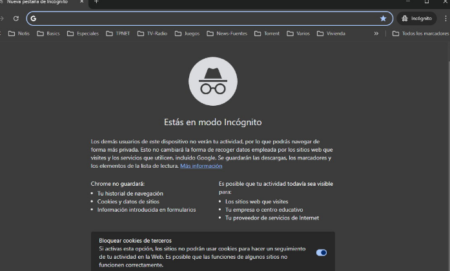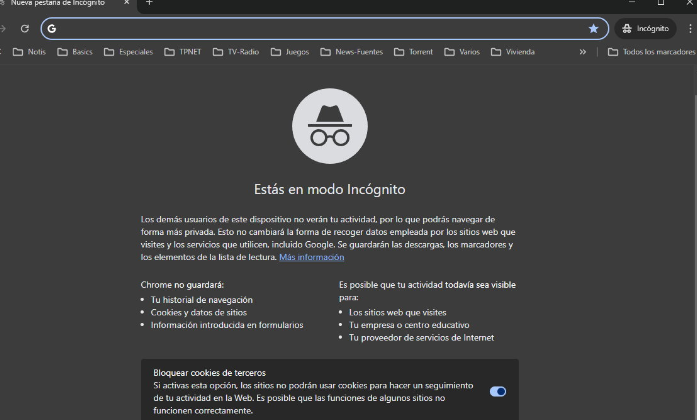Incognito mode is a function focused on improving user privacy and security, which all web browsers support today. A temporary private browsing session that does not share data with the browser, does not save information about web pages, browsing history, web cache, passwords, form information, cookies or other website data, deleting these or other temporary files when We end the session.

At this point we must make the usual warnings. “Private browsing” (although very useful in several scenarios), is not the same as “anonymous browsing” , a feature that requires other more advanced tools such as TOR . And incognito mode is not anonymous nor does it offer as much privacy as it promises. Google’s recent changes to the disclaimer on this topic better reflect what this incognito mode is (and is not).
What is Incognito Mode used for?
Focused on safeguarding the privacy and security of the user, the main feature of this mode is that it allows web browsers not to store information about the page we are browsing. Although private browsing is not 100% guaranteed and making it clear that it is not the same as “anonymous browsing” that other tools such as TOR require , incognito mode is very useful in several scenarios such as:
- Economic transactions . Purchases with credit cards and service accounts such as PayPal, administrative procedures or others, without leaving information about them, as you can review in this article to ensure online purchases .
- Access to a website with several accounts at the same time . Most websites do not allow you to log in with more than one account at a time. But private browsing mode offers a solution. You can stay authenticated in the main browser window and open a private browsing tab to use a second account.
- Use of third party equipment . If you have to use a family member or friend’s computer, private browsing allows you not to leave traces of your task and not disable access to the equipment owner’s services as usually happens, having to log out of their accounts to use yours.
- “Pure” search engine results . Search engines like Google use your search history and other information they have collected from you (a lot) to display personalized search results. This is usually useful because it is based on your interests, but sometimes you may want to see the general search results that the engine offers and that other users see, to see how certain terms are positioned, for example your name or the of your company. A session in incognito mode should give you the most “pure” results possible. This method works with all web engines.
- Electronic commerce . Following the previous usage, imagine that you are researching the online purchase of a product that you want to buy online, for example Amazon, which like any site that offers personalized experiences based on your user account or previous activity, will remember that you were searching for that product. kind of product. Amazon will not only “chase” you on its portal but on other websites you visit. If you don’t want this to happen, you can use a private browsing window. The activity will not be associated with your Amazon or other e-commerce retailers account. Private browsing also offers other interesting uses in e-commerce. For example, if we want to surprise with the gift of a product and we do not want to leave a trace or book a vacation trip or similar.
- Reading or access limits . Some websites limit reading access to a small number of free articles, whether daily, weekly or yearly, requiring a subscription payment once access is exhausted. If, as is normally the case, access control is carried out based on cookies, you can use private browsing to overcome the limit. Of course, be honest and use this technique only temporarily. If you like the site consider subscribing because it will be the only way to maintain it in the future. You already know the difficulties of the media simply to stay online.
- Adult sites . We have left it for last, but according to statistics, it is another of the greatest uses of private browsing, because it prevents – for example – minors in the house from accessing material that is not appropriate for their age. Or that your partner discovers the girls/boys you entertain with… As in other previous uses, there is not 100% privacy security especially on some web portals, but it is always better than standard browsing.
Incognito mode in major web browsers
All major browsers offer private browsing, although not all have advanced features to disable add-ons or toolbars; recover tabs opened in incognito; block all trackers and ads or incorporate VPNs.
They do perform the basic main actions that we can request for private browsing, without storing cookies or form information and deleting temporary cached files, browsing history and searches. Its use is very simple in all browsers.
- Google Chrome . Quick access with the keys «Ctrl + Shift + N» or by clicking on the configuration tool (Customize and control Google Chrome) in the upper right corner > “New incognito window”. In addition to the basics (do not save browsing history, cookies, forms, etc.), Chrome disables installed plugins. It also warns that the activity is not 100% private and may still be visible to the ISP, company or educational center if you are on their network.
- Mozilla Firefox . Quick access with the keys «Ctrl + Shift + P» or by clicking on the Menu in the upper right corner > “New private window”. In addition to Chrome’s features, it recovers tabs in incognito mode and is the only one that directly blocks advertising and other types of tracking. On the other hand, it does not disable plugins or navigation bars.
- Microsoft Edge . Quick access with the “Ctrl + Shift + P” keys or by clicking Settings > “New InPrivate Window”. Offers the basics explained in Chrome.
- Opera . Quick access with the keys «Ctrl + Shift + N» or by clicking on the configuration tool (Customize and control Opera) in the upper left corner > “New private window”. Optionally blocks default content for online trackers and is the only one that includes its own VPN.
- Internet Explorer . Quick access with the keys «Ctrl + Shift + P» or by clicking on the Tools Menu in the upper right corner > Security > “InPrivate Browsing”. Everything from Chrome, the addition of tab recovery and optionally blocking trackers and advertising.
In summary. All major web browsers offer the basic features that can be requested in an incognito mode. It is not 100% private browsing and it is not anonymous browsing, but it provides greater privacy than the standard browsing mode for multiple uses .
